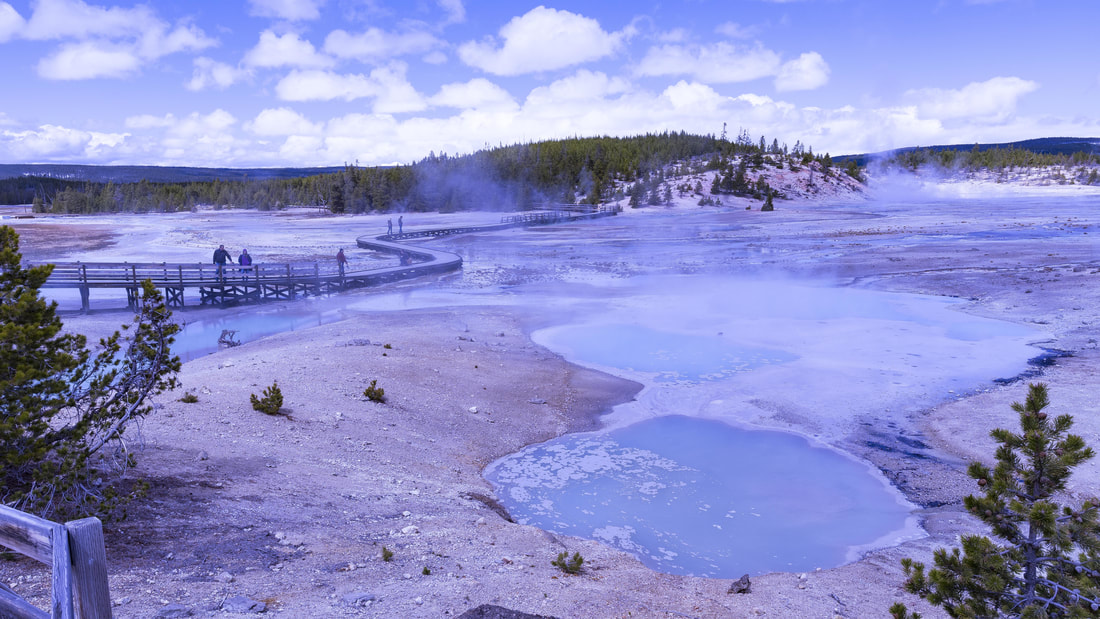|
It was places like this at Yellowstone that ushered in the era of dinosaurs hundreds of millions of years ago after killing off most of earth's life and a subsequent period of recovery that took millions of years. Today this odd spot in northwestern Wyoming is where a current of the earth's magma has gone off course and created an incredibly hot stream so close to the surface that geysers like Old Faithful spout steam into the atmosphere on a regular basis. About 252 million years ago, scientists believe this movement of magma from the earth's core to its surface became more norm than exception creating in Siberia alone cracks in the earth's surface that spewed magma and toxic gasses over an area larger than Western Europe. The result was a toxic planet of hyper volcanic activity that destroyed more than 90% of the species on our planet - a mass extinction - and took millions of years to subside. It was the end of the Permian age and most of its many creatures. Animals now referred to as edaphosaurs, dimetrodons, eryops, and most archosaurs, amphibians, and fish perished. But as time passed, and things normalized, it became an opportunity for new animals, the dinosaurs, to fill niches that no longer had edaphosaurs or dimetrodons for competition. The dinosaurs would turn out to be extremely successful and diverse. For those of us raised in the 1960s and 70s, this may seem like an odd statement. After all they went extinct and were slow moving creatures of limited intelligence, at least so we were taught. But exploration and discovery over the last several decades has debunked that view of dinosaurs. And new tools have enabled paleontologists to puzzle together a more accurate view of life in the age of dinosaurs, one that is much more complex and intriguing. New dinosaurs are discovered at a rate of one per week these days adding more knowledge about who these creatures were and what their lives were like. Think there is nothing relevant to learn from dinosaurs? Think again. Their era on this fragile and ever changing planed last from 252 million ago to 66 million years ago, a staggering 186 million years. Compare that to the 200,000 years humans have been on the planet or 6 million years for our ancestors and you will understand that dinosaurs just might have something to teach us. Imagine what we humans might be if we survive half as long as the dinosaurs, for say a mere 90 million more years. Recent dinosaur discoveries include a complete fossilized skeleton of the Zhenyuanlong, a mule sized flying dinosaur with preserved bone and feathers that had delicate legs like a modern Great Heron. Found in China in 2014, it looks much more like a modern-day bird than a dull witted, slow moving 'dinosaur.' Which brings me back to the present, the joy of spending time at Yellowstone National Park with its amazing geothermal features and the recent excitement of discovering a colony of Great Blue Herons nesting along the shore of a North Georgia lake. Both are reminders of the great diversity of our planet and life.
Its a great time to be alive, if only we can survive the changes facing our planet as well as did the dinosaurs. ---------- Images and text copyright Clinton Richardson. To see more images from Yellowstone or of the Great Blue Herons at what I call Jurassic Cove, check out our galleries at TrekPic.com. If you like these posts, please tell your friends about the Venture Moola blog at Readjanus.com. And, feel free to share this blog. The more readers the better. Click here to subscribe to a weekly email that tells you when we issue new entries. Or, click in the column to the left to follow us on Facebook or Twitter. The venture moola blog comes to you from Atlanta, Georgia. Find it at readjanus.com. Copyright Clinton Richardson.
11/17/2018 02:42:14 am
I always wonder what will happen to people if we co-exists with dinosaurs. I'm glad that God did not allow it to happen. I also read that the dinosaur color skin in the pictures I see in books are not the actual color cause all they have seen in a dinosaur are just bone fossils. There is no clear reason why they become extinct, but they have sight different theories of dinosaur extinction. Whatever the truth is, I'm still filled with wonder for the colossal being that they are. Comments are closed.
|
the blog
Travel, history, and business with original photos.
your hostClinton Richardson - author, photographer, business advisor, traveler. Categories
All
Archives
July 2023
Follow us on Facebook
|
Check out Ancient Selfies a 2017 International Book Awards Finalist in History and 2018 eLit Awards Gold Medal Winner and
Passports in his Underpants - A Planet Friendly Photo Safari a 2020 Readers' Favorite Winner in Nonfiction
Site Copyright 2024 by Clinton Richardson





 RSS Feed
RSS Feed